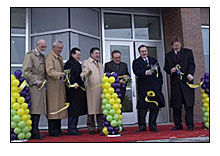ROCHESTER, N.Y., March 6, 2006 -- The IT Collaboratory, a research collaboration among the Rochester Institute of Technology, the University at Buffalo and Alfred University, officially moved into a new facility with the formal dedication on Friday of the $30 million IT Collaboratory research building -- a three-story, 32,000-sq-ft structure on the RIT campus.
Started in 2001 with a $14 million grant from the New York State Office of Science, Technology and Academic Research (NYSTAR), the IT Collaboratory's purpose is to create key technologies and systems while developing a skilled workforce that will play a major role in the economic revitalization of upstate New York. Collaborative research at the center focuses on microsystems, photonics, remote sensing systems and nanomaterials and is performed by scientists and engineers from RIT who work with those from the University at Buffalo's Institute for Lasers, Photonics and Biophotonics and the New York State College of Ceramics at Alfred University. All three schools are located within a two-hour drive of each other.

RIT dedicates the IT Collaboratory Research Building, a project made possible through a $14 million grant from the New York State Office of Science, Technology and Academic Research (NYSTAR). Among those taking part in the March 3 ceremony were (from left to right) Don Boyd, RIT vice president for research; Mike Morley, president of RIT's board of trustees; Joseph Morrelle, state assemblyman; Jim Alesi, state senator; Russell Bessette, executive director of NYSTAR; Albert Simone, RIT president; and John Kelly, senior vice president of technology and intellectual property at IBM. (RIT Photo by A. Sue Weisler)
“The opening of the IT Collaboratory is further proof that our efforts to transform the Finger Lakes region into a global leader of high-tech research and development are working,” said Gov. George E. Pataki. “New York’s Finger Lakes attracts millions of dollars in new investment and has become the place where cutting-edge research and development takes place, helping to make New York state an international leader in high-tech development, and helping to create new jobs and opportunities for New Yorkers.”
The IT Collaboratory is among eight strategically targeted academic research (STAR) centers. Combined, these centers represent one of the largest one-time high technology and biotechnology related investments in state history, according to NYSTAR. Research conducted by scientist and engineers within the IT Collaboratory has already resulted in more than $26 million in research grants, 27 invention disclosures, 18 patents issued or pending and four startup companies established, according to RIT. Completion of the new building represents the next stage in the center’s evolution, providing its partners with much-needed research space and equipment.
The first two floors include shared spaces for metrology, sensor development and the Lobozzo Optics Laboratory. There is also dedicated research and faculty space for nanolithography, remote sensing systems and the radio frequency analog mixed signal lab. The third floor is equipped as an integrated microsystems laboratory through a partnership with Analog Devices Inc.
RIT President Albert Simone said he believes research opportunities within the new center are crucial to enhancing students’ academic experiences, which he said has a broader impact. “The region and the state as a whole will realize benefits as students become intrigued with the research that they will participate in at this new center, follow that work to the companies that emerge and then stay in western New York to build their careers,” says Simone.
For more information on the IT Collaboratory, visit: www.rit.edu/itcoll